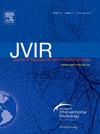Safety and Effectiveness of Early Primary Stent Placement for Hepatic Artery Stenosis in Liver Transplant Recipients
IF 2.6
3区 医学
Q2 PERIPHERAL VASCULAR DISEASE
Journal of Vascular and Interventional Radiology
Pub Date : 2024-11-23
DOI:10.1016/j.jvir.2024.11.019
引用次数: 0
Abstract
Purpose
To evaluate the outcomes of early primary stent placement (within 30 days of liver transplantation) for hepatic artery stenosis (HAS).
Materials and Methods
Patients who underwent liver transplantation between February 2001 and February 2024 were evaluated for HAS. Patients who underwent primary stent placement were selected and stratified based on the time from anastomosis to intervention. Early intervention was defined as primary stent placement within 30 days of surgical anastomosis. Kaplan-Meier analysis was performed for primary patency.
Results
HAS occurred in 83 of 779 (11%) patients (median age, 55 years; interquartile range, 48–63 years; 27 [48%] women), with 56 patients meeting inclusion criteria. Stent placement was performed within 0–6 days of the anastomosis in 11 (20%), 7–14 days in 11 (20%), 15–30 days in 7 (12%), 31–70 days in 9 (16%), and >70 days in 18 (32%) patients. Technical success was 100%. Primary patency rates were 89%, 87%, and 87% at 1, 3, and 5 years, respectively. Primary assisted patency rates were 100% at 1, 3, and 5 years. Early interventions at 0–6 days, 7–14 days, and 15–30 days showed primary patency rates of 100%, 90%, and 86%, respectively, at 1 year (P = .58). There was no difference in primary patency between the early (<30 days) and late (>30 days) cohorts (P = .88). There was 1 Grade 4 adverse event. There were no cases of anastomotic rupture, hepatic artery dissection, or graft failure.
Conclusions
Hepatic artery stent placement within 30 days of liver transplantation is safe and technically successful with excellent long-term primary patency.

肝移植受者肝动脉狭窄早期初次支架置入的安全性和有效性
目的:评估肝动脉狭窄(HAS)早期初次支架置入(肝移植后30天内)的效果:方法:对2001年2月至2024年2月期间接受肝移植的患者进行肝动脉狭窄评估。根据从吻合到介入治疗的时间选择并分层。早期介入治疗的定义是在手术吻合后 30 天内放置原发性支架。对初治通畅率进行卡普兰-迈耶分析:83/779(11%)名患者(中位年龄 55 岁(四分位距:48 - 63),27(48%)名女性)中有 56 名患者符合纳入标准。在吻合后 0-6 天内放置支架的患者有 11 人(20%),7-14 天的患者有 11 人(20%),15-30 天的患者有 7 人(12%),31-70 天的患者有 9 人(16%),超过 70 天的患者有 18 人(32%)。技术成功率为 100%。1年、3年和5年的初次通畅率分别为89%、87%和87%。1年、3年和5年的初次辅助通畅率为100%。在 0-6 天、7-14 天和 15-30 天进行早期干预,1 年后的初次通畅率分别为 100%、90% 和 86%(P = 0.58)。早期(30 天)组间的一次通畅率没有差异(p = 0.88)。有 1 例 4 级不良事件。无吻合口破裂、肝动脉夹层或移植物失败病例:结论:在肝移植术后30天内放置肝动脉支架是安全的,技术上也是成功的,并且具有良好的长期原发性通畅性。
本文章由计算机程序翻译,如有差异,请以英文原文为准。
求助全文
约1分钟内获得全文
求助全文
来源期刊
CiteScore
4.30
自引率
10.30%
发文量
942
审稿时长
90 days
期刊介绍:
JVIR, published continuously since 1990, is an international, monthly peer-reviewed interventional radiology journal. As the official journal of the Society of Interventional Radiology, JVIR is the peer-reviewed journal of choice for interventional radiologists, radiologists, cardiologists, vascular surgeons, neurosurgeons, and other clinicians who seek current and reliable information on every aspect of vascular and interventional radiology. Each issue of JVIR covers critical and cutting-edge medical minimally invasive, clinical, basic research, radiological, pathological, and socioeconomic issues of importance to the field.

 求助内容:
求助内容: 应助结果提醒方式:
应助结果提醒方式:


